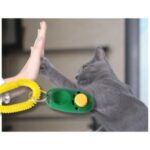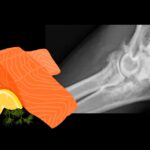Dogs and cats may get a feel-good “high” from licking food off of a mat like the endorphin release runners get, ie. the runner’s high.
Pet owners are increasingly looking for solutions to soothe anxious and bored pets. Google searches for lick mats have increased 700% over the last 5 years, with about 1600 searches per month, as owners look for enrichment options.
What Is a Lick Mat?
A lick mat is a flat mat made of rubber or silicone with a textured surface designed to spread out your pet’s favorite treat, such as peanut butter, wet food, or yogurt. The idea is simple: the textured grooves and patterns make it challenging for your dog or cat to lick up all the food. It’s like a puzzle for their tongue.
The Purpose Behind the Lick Mat:
- mental stimulation
- alleviate boredom
- reduce anxiety
- help slow down eating
- distraction during grooming, physiotherapy or veterinary procedures
Some companies propose that this licking releases calming and happy hormones like dopamine and endorphins.
Does the science support this?
Well, yes and no.
Studies do show that self-soothing behaviors, like repetitive licking and grooming lead to release of endorphins and dopamine. These hormones are the feel-good compounds that reduce anxiety.
But…there is no specific research that isolates licking mats specifically as a behavior leading to dopamine or endorphin release in dogs.
How can we use them?
- Distraction During Grooming: Keeps pets calm and occupied during nail trims, baths, or brushing.
- Reducing Anxiety: Helps soothe pets during stressful events like car rides, thunderstorms or fireworks.
- Slow Feeding: Prevents gulping by making pets eat more slowly. Only practical for small dogs.
- Vets Little Helper: great for nail trims, water therapy after injury, wiggly puppy exams
Any Problems?
Potential for gastrointestinal obstruction:
Any rubber or silicone material covered in food has the potential to be chewed and swallowed. When that happens, the foreign material may get stuck in the stomach or small intestines, and it may obstruct the flow of food and liquid.
Pictured below are two case report photos from Walkerville Vet in the U.S.. The small blue piece on the left was removed surgically from a cat’s intestine. The photo on the right shows the stomach contents of a patient after the vet induced vomiting. The owner had realized right away that her dog had chewed and swallowed the mat, and the vet was able to induce vomiting and remove the remains of the mat before it could cause an obstruction.
Some pets can even chew and destroy the “Tough” version of the LikiMat brand, made with more durable rubber. Pets should be supervised with this enrichment tool, it should not be given to pets left alone.
Hygiene concerns:
These mats can be difficult to clean, given all the grooves! Be sure to wash carefully and not use raw food as the treat.
Over-Feeding Concerns:
Keep in mind that everything given as a treat needs to be taken into account when considering daily calories and feeding amounts. A good rule of thumb is to try to keep treats to less than 10% of the total intake for the day.
To make the most of a lick mat, choose one made from durable, pet-safe materials, supervise your pet during use, and ensure it’s properly cleaned after each session.

